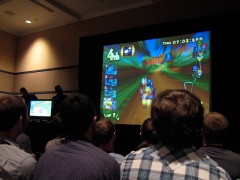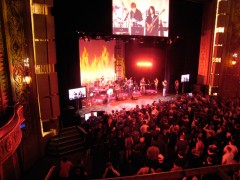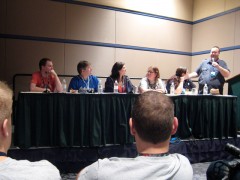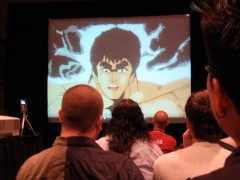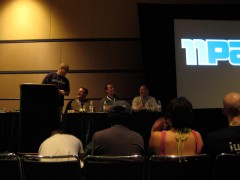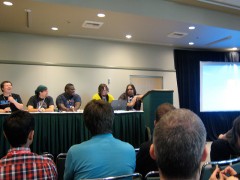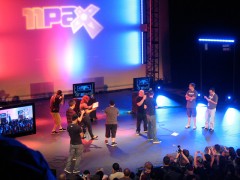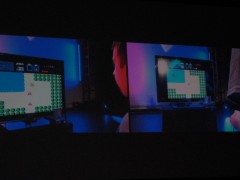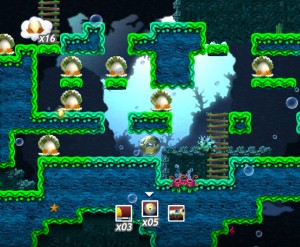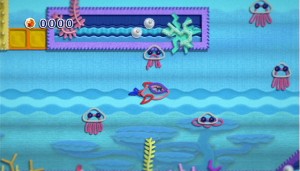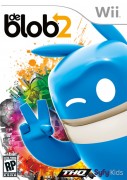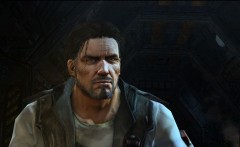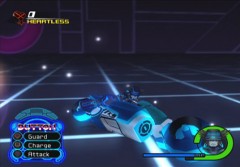Until recently, I had never played a Legend of Zelda game before. This is true. I had gone throughout my entire life never having rescued Zelda, the Triforce, and/or Hyrule from the clutches of evil. With the exception of Twilight Princess, which I had watched my husband play through much of, my familiarity with the Zelda franchise had been mainly limited to everything outside of the games, including the infamous cartoon show, some of the comics, and the characters’ cameos in the likes of the Smash Bros. series.
This changed for good when, after PAX, I got the urge to play The Legend of Zelda, and play it seriously. As I implied in an earlier post, the Omegathon bears much of the blame for this decision. In the end, though, I’m glad I made it.
The Legend of Zelda came out in the US in the mid-to-late 80s, when the Nintendo hype machine was starting to build the company up to incredible heights. Zelda and its shiny golden cartridge helped usher in a new franchise, one which is widely loved and stands apart from so many other games. Often I’ve wondered what the deal is with this series. Why is it so special? The answer is undoubtedly different for each person, but after playing through the original game, I have a new appreciation for Zelda in general.
The game opens with a simple title screen, which is followed by a brief bit of text which establishes the plot. The Triforce of Power has been stolen by Ganon, and Princess Zelda broke the Triforce of Wisdom into eight parts before being taken away herself. It is therefore up to Link, the hero, to find the scattered pieces of this latter Triforce and rescue the princess. What follows next is a list of all the items which can be found in the game, along with a note to refer to the manual for more info. Seeing as how I was playing this game via The Legend of Zelda: Collector’s Edition for the GameCube, there wasn’t much information in the manual for this one game, and little about the items in particular. Still, I managed to figure out most of these details on my own.
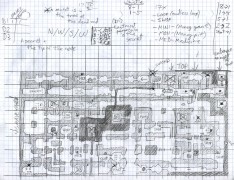
Upon starting the game, I found myself in the middle of a path surrounded by green cliffs. A cave was in one of them. Walking eastward, I happened upon a forest full of monsters. At that moment, I realized I have nothing to defend myself with. I went back to the starting area and entered the cave. An old man was there with a sword; he said, “It’s dangerous to go alone! Take this.” And thus, my adventure began in earnest.
The game’s world is surprisingly big, but only little chunks of it are seen at any given time. There is a map at the top of the screen along with other crucial information, such as my health meter and the number of bombs I have on me, but it is Atari 2600 levels of crude. After wandering around and getting lost several times during initial play sessions, I decided to dig out some graph paper and draw my own map. This helped matters immensely. I must also note that the individual dungeons have in-game maps as well, but these are generally smaller in scope and much easier to read, and thus I didn’t feel the need to map these areas myself until I was past the halfway mark.
Another aspect of the overworld that I noticed early on is its openness. For instance, it is entirely possible to walk into the “Level-5” dungeon when you’re at a “Level-1” state. There are a lot more caves besides that first one, with more people to talk to (and/or get items from); also, the enemies get progressively harder the further out one explores. I can imagine being ten years old again, playing this for the first time and being genuinely impressed by this overworld. Hell, I found myself impressed by it here in 2011.
The wide variety of items available is also impressive. Aside from expected fare like health regenerators (hearts, potions) and currency (rupees, or “rubies” in the NES manual), there are secondary weapons such as the boomerang, which comes back to you on every toss—even if you move somewhere else in the meantime. However, it took me awhile to figure out how to actually use it (hadn’t yet downloaded the original manual at that point), and even afterward, it was pretty much useless until I got the upgrade. One item, the red candle, seemed not to work as described; same goes for the meat, until I found that it serves a very specific purpose.
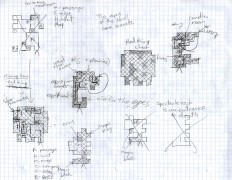
Certain items are needed in order to get further in the game, and become harder and harder to find as one goes along. One of the most devilish tricks the game pulls is the location of the Red Ring, which is the best armor available. On that note, there are (comparatively speaking) tons of secrets hidden throughout the game, especially in the overworld, in that old-school, tough-as-nails 8-bit-era way. There are hints about new items and areas scattered here and there, but a couple of them are awfully vague. Here then is the purest evidence that this is a video game from an era when such things were expensive, and (in this country, at least) were usually bestowed upon children as birthday and/or holiday presents, and thus had to last them for months on end. These days, such deeply buried secrets—especially those that are needed in order to progress—have rightly fallen out of favor amongst both developers and players, but there is, admittedly, an odd sort of satisfaction when randomly discovering something you had no idea was there. Still, that did not at all outweigh the mild frustration I felt over being unable to progress (or get a specific item) at certain points.
The game’s graphics are clear and simple throughout, with a limited palette that gets the job done. The animation is what one would expect from an NES game of this vintage, as are the sound effects. The Collector’s Edition does a good job of displaying everything in HD, though screens heavy with enemies are accompanied by an annoying slowdown. As for the music, it is repetitive. There are only about five or six pieces throughout the entire game, and two of them are heard constantly (on the overworld and in the eight Triforce piece dungeons), but are thankfully catchy. It’s little wonder then that these two pieces have since gone on to become much loved classics of game music.
All told, The Legend of Zelda has stood the test of time much better than other 8-bit games, and despite its more antiquated aspects, is quite playable today. It is a very important title in the history of video games, but it took my actually playing it to realize the weight of this importance. Its genre is hard to pin down—though I think it bears the greatest resemblance to a Metroidvania—but its influence is pervasive in many games that have followed since, clones or not. For instance, with only the first Zelda taken into account, a modern game series that strikes me as being very similar to it without being an outright clone is Grand Theft Auto. The GTA series’ open worlds, loose mission structures, hidden goodies, and so on are extremely reminiscent of its fantasy-based predecessor. I’m sure if I give it more thought, I can find touches of Zelda in countless other games, whether obvious or not.
My total experience as a gamer has been enriched by playing this one title—incredible it must have been then, and still fun today—and as such, I must recommend it to anyone wanting (or needing) a deeper sense of video games’ rich history. Finally, if you do play it, the excellent walkthrough at Zelda Dungeon is a great resource, should you feel the need for one at any point. After all, it can be dangerous to go alone.
Brainscraps Mailbag: So far, I’ve heard from one of the cosplayers featured in PAX Pix 2011, Part Four; a “cosplay credits” section has been added to the end of that entry (and its crosspostings). Anyway, here’s the email from Peter Jung:
Hi, I saw that you did a piece on the cosplay of PAX with a picture of me (as Community Outreach Gordon) on the front. Just wanted to say thanks, that totally made my day. I’m thinking next year I should start putting my email on the brochures, as they were a way bigger hit than I thought they’d be. Or just make a real HEV suit already. Anyway, glad you enjoyed it, I do it for the fans. And to say in a non-aggressive way to Valve, people still want a half life game.
Thank you,
-P.
Thanks for your email, Peter! And once again, if your cosplay is featured in that post, please let me know and I will be happy to credit you.
